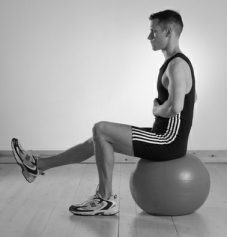Once the correct contraction has been identified, it needs to be used to assist the spine during dynamic activity. Level 2 introduces simple movement tasks. Level 3 uses more complex movement tasks.
Exercise 3


Starting position:
As for Exercise 1.
Activity:
Recruit the core muscle as in Exercise 1. Keep the muscles recruited and lower the right knee slowly towards the floor, pause then return to the starting position. Both feet remain static and maintain contact with the floor. There should be no movement at the pelvis. The lumbar spine should remain in the neutral position.
Repeat ten times on each side.
Exercise 4


Starting position:
As for Exercise 1.
Activity:
Recruit the core muscles as before and then slowly lift the right foot 1 to 2cm from the floor and then lower back to the floor. No pelvic or lumbar spine movement should occur.
Repeat ten times on each side.
Progression 1: Having lifted the foot 1 to 2cm above the floor, straighten your knee, still holding the foot 1 to 2cm above the floor and then return to the start position. No lumbar or pelvic movement.
Progression 2: Perform with the pelvis on an unstable surface such as a cushion or "Sit fit".
Exercise 5

Starting position:
Sitting on a chair with knees and hips bent to 90 degrees, feet resting flat on the floor. Maintain an upright body posture with the neutral lumbar spine.
Activity:
Slowly lift your right foot from the floor and then straighten your leg out in front of you. Maintain your upright starting position with the neutral lumbar spine.
Repeat ten times.
Progression 1: Perform while sat on a `Swiss Ball'. Neither the ball, your pelvis or lumbar spine should move during the activity.
Progression 2: As progression 1 but the supporting leg is also on an unstable surface such as a cushion or "Sit fit".






